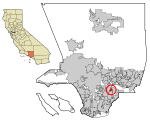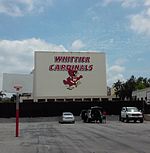Pío Pico State Historic Park
Adobe buildings and structures in CaliforniaBuildings and structures on the National Register of Historic Places in Los Angeles County, CaliforniaCalifornia Historical LandmarksCalifornia State Historic ParksHistoric house museums in California ... and 10 more
History of Los AngelesHistory of Los Angeles County, CaliforniaHouses in Los Angeles County, CaliforniaHouses on the National Register of Historic Places in CaliforniaMexican CaliforniaMuseums in Los Angeles County, CaliforniaParks in Los Angeles County, CaliforniaProtected areas established in 1927San Gabriel ValleyWhittier, California

Pío Pico State Historic Park is the site of El Ranchito, also known as the Pío Pico Adobe or Pío Pico Mansion, the final home of Pío Pico, the last Governor of Alta California under Mexican rule and a pivotal figure in early California history. Located in Whittier, California, at 6003 Pioneer Blvd. near Whittier Blvd. and Interstate 605, it is California Historical Landmark No. 127, listed as "Casa de Governor Pío Pico". Just west of the park is the San Gabriel River. Across the river is the city that bears his name—Pico Rivera. The park consists of the adobe and about three acres of surrounding land.
Excerpt from the Wikipedia article Pío Pico State Historic Park (License: CC BY-SA 3.0, Authors, Images).Pío Pico State Historic Park
Pioneer Boulevard,
Geographical coordinates (GPS) Address Nearby Places Show on map
Geographical coordinates (GPS)
| Latitude | Longitude |
|---|---|
| N 33.993636 ° | E -118.071075 ° |
Address
Pico Adobe
Pioneer Boulevard 6003
90606
California, United States
Open on Google Maps








